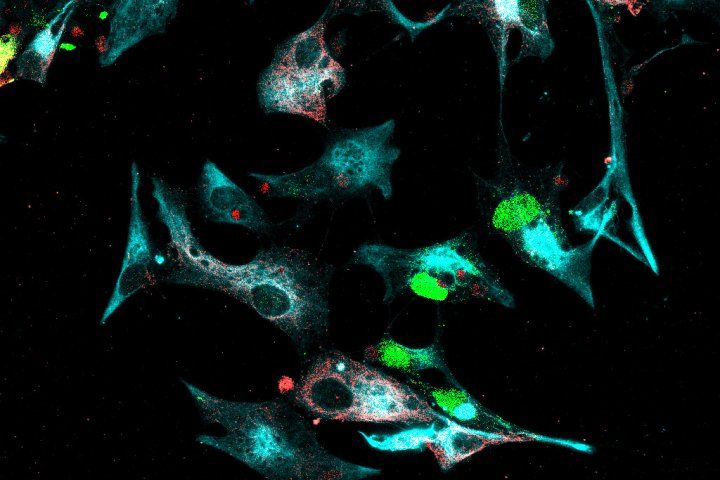
Image shows staining for GPX3, a radial glia cell marker gene, transcripts (white dots), nuclei (blue) CRISPR virus perturb non-coding DNA sequence interaction with GPX3 gene promoter (green), and control CRISPR virus (red) in radial glia (light blue).
Risks for neuropsychiatric disorders including autism, schizophrenia and attention deficit hyperactivity disorder (ADHD) are in part genetically determined. Now UC San Francisco researchers are finding new clues to how these disorders unfold by focusing on the role of a little-studied form of DNA in early brain development.
Like a late-night driver who looks for lost keys only under a lamppost, scientists had for decades lacked tools to shed light on the roughly 98 percent of the human genome that is not made up of genes, the specialized DNA segments that serve as blueprints for proteins. But this long-neglected "noncoding" DNA finally has become a hot research topic.
In a study published Oct. 14 in Nature, UCSF scientists used new tools to map - in three dimensions - how this "dark matter" of the genome is modified, organized, and physically interacts with the rest of the genome in particular cells to turn genes on or off during the brain's early development. The study was a collaboration between the labs of Yin Shen, PhD, associate professor in the UCSF Institute for Human Genetics, Arnold Kriegstein, MD, PhD, director of the UCSF Eli and Edythe Broad Institute of Regeneration and Stem Cell Research, and Ming Hu, PhD, a scientist at Cleveland Clinic's Lerner Research Institute.
All cells in any individual have essentially identical DNA; it's the orchestration of genes being switched on and off in an orderly way that allows the organism to develop hundreds of specialized cell types that all work together. This orchestration is largely driven by so-called epigenetic status - chemical flags, changes in DNA organization, and other modifications that take place outside the genes themselves.
In their new study the researchers identified DNA sequences that stand out as "super interactive promoters" (SIPs). These sequences interact with far flung DNA regulatory sequences across the genome to trigger the activation of specific genes, many of which serve critical functions in early brain cells, including radial glia, which give rise to all the cells that ultimately make up the complex circuitry of the brain's cerebral cortex, the researchers found.
"Thousands of DNA variants associated with neuropsychiatric diseases reside in the dark matter, which makes their function very challenging to study," said Shen, also a member of the Department of Neurology in the UCSF Weill Institute for Neurosciences. "For the genetics and neurobiology research communities, these results will help to prioritize the study of specific genetic variants in neuropsychiatric disease."
Shen's team developed a variant of CRISPR gene-targeting technology that they call "CRISPRview," which allows them to verify the functions of genetic switches. The researchers were able to use the tool to perturb a DNA switch and then to observe effects on the activation, or "expression," of the genes targeted by the switch in human brain cells.
"For the first time, we used CRISPR directly on individual cell types from the human brain to get a precise readout of how non-coding DNA sequences control gene expression, at single-cell resolution in a mixture of cell types," Shen said.
By identifying genes controlled by SIPs and other DNA sequences and linking them to known DNA variants associated with disease, researchers can begin to identify biochemical pathways and functions involved in complex neuropsychiatric diseases, according to Shen.
For example, DNA variants associated with autism spectrum disorder were found to be linked in both progenitor cells and neurons to genes that affect the folding and accessibility of the DNA within chromatin, the tightly coiled "packaging material" that makes up chromosomes. Because genes must be physically accessible to a cell's molecular machinery to be read (or epigenetically modified), any changes to which DNA segments are exposed or hidden away in particular brain cell types can influence their role in neuropsychiatric disease.
"These are complex disorders that are not driven by just one gene," said UCSF's Kriegstein, the John Bowes Distinguished Professor in Stem Cell and Tissue Biology. "This study highlights the need to understand how ensembles of genes function during brain development and throughout life."






